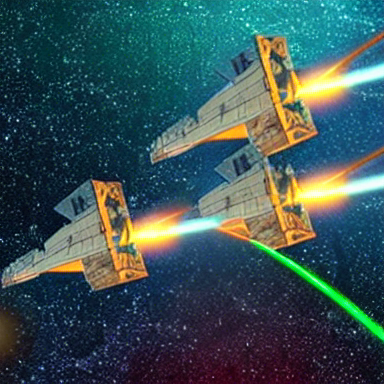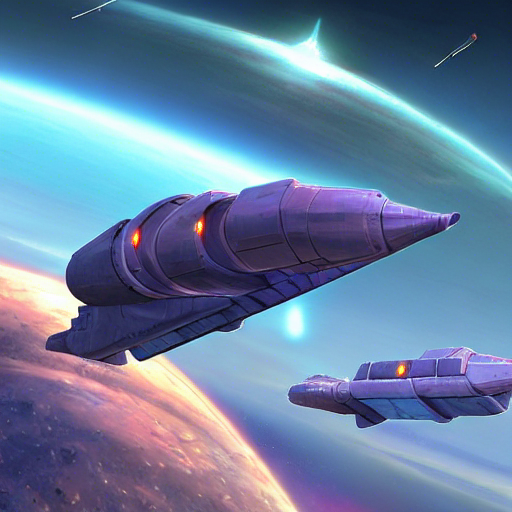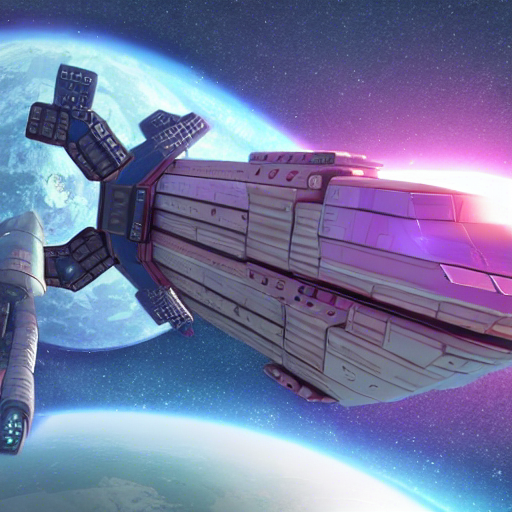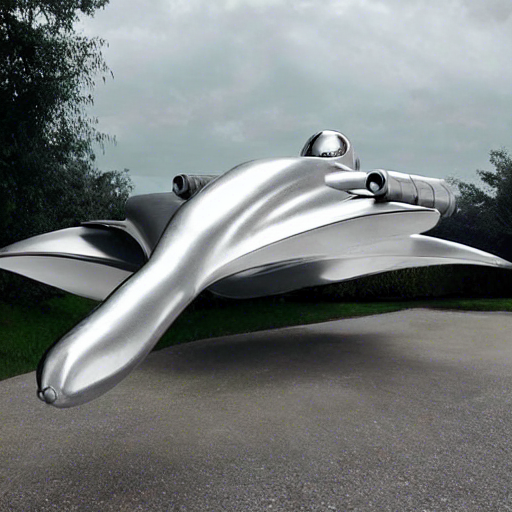There are many different classifications of spacecraft in charted space and the M317 Cluster. In many cases the borders are rather fuzzy and what is called a frigate in one pocket empire might be a destroyer in the next. Other terms have very precise meanings that are observed in most systems.

Starship is a term restricted to those with jump capability, while spaceship tends to refer to any ship that functions out in space. System vessels refer to craft which lack jump engines and require a tug (starship equipped with large docking clamps and oversized engines) to travel from system to system. Many class B and C starports produce their own system vessels (Class C starports are restricted to small craft), and ton for ton system craft are more efficient ships as they do not need to carry jump engines or the large amounts of fuel needed to propel starships between systems.
Fighters typically refer to short range military vessels of 10 or 20 tons that can be deployed in relatively large numbers. Regular fighter patrols near common hijacking points can often dissuade pirates or privateers from spending time in a system. Individual fighters are usually not able to take out even a modest starship, but they are rarely found alone and are perfectly able to call for reinforcements.
Bombers are often small craft which carry more significant firepower, such as barbettes or double/triple particle beam turrets. Hits from nuclear armed missiles will often damage even capital ships and thus demand attention from any hostile force. Because they are small craft, however, they have only a single hardpoint and thus lack defenses against smaller vessels. Bombers rarely act alone and often work in concert with fighters or planetary defense satellites to maximize their effectiveness.

Escort ships in military parlance refer to smaller, less capable craft that often act in squadrons or fleets and shield other vessels from attacks. Convoy duty is often carried out by escort class vessels. While larger escorts can certainly damage a capital ship, a capital warship has substantially more firepower than any individual escort vessel.
Capital ships in the M317 Cluster are those of 1500 to 5000 tons and represent the largest starships able to enter jumpspace. System vessels may be larger, but they cannot project power because they cannot reach other star systems. Capital ships represent the most capable vessels in a system's fleet and are not committed lightly to any mission.
Corvettes are the smallest independent military ships and typically run from 200 to 500 tons. Because of their size they are often rather specialized in their mission options, but are usually deployed in relatively large numbers because they are inexpensive military starships.
Frigates (along with destroyers) serve as the backbone of many fleets. Generally 400 to 800 tons, they are more capable than corvettes but cheaper than destroyers. While corvettes occasionally carry a single bay weapon, military frigates often have this option but rarely can afford the tonnage for more than 1 bay weapon.
Destroyers are the largest of the 'escort' ships in a fleet and mount significant firepower on their own. They have a large range of about 600 to 1400 tons, but the upper limit is generally respected as piloting larger vessels require the capital ship piloting skill. Only the largest pirate vessels willingly engage a destroyer class vessel as few are willing to mount this much firepower while being able to collect reasonable amounts of cargo.

Cruisers are the smallest capital ships and serve as the main power projection element of a fleet. They start at 1600 tons and reach about 4000 tons, offering a significant range of options. They are often divided into 3 different categories, with light cruisers in the 1600-2500 ton range, standard cruisers in the 2000-3000 ton range, and heavy or battle cruisers in the 2500-4000 ton range. Cruisers may specialize in particular missions, such as deep strike, planetary assault or multi-role vessels, but often have capabilities outside of their specialization. Cruisers can serve as command ships during fleet deployments or as very capable support vessels for carriers, battleships, and dreadnaughts.
Monitors are larger in-system craft which typically carry a heavy weapons load and for their size as they do not have jump engines. They routinely maximize their gravitic engine power, allowing them to mount more bay weapons and/or marines to destroy or capture enemy ships. Monitors are not restricted by the size of vessel able to enter jump space and may be the largest vessel in any system.
Carriers are characterized by having a large percentage of their tonnage committed to hangars and/or docking bays. They typically carry military small craft to provide their primary striking power. Small carriers can make excellent escort vessels for a convoy of civilian ships, while large carriers can supply a fleet with significant screening capability. In a direct slugfest with a dedicated military ship of the same size, however, carriers rarely have the heavy weapons found on other fleet warships of similar tonnage.
Battleships and Dreadnoughts are the largest military starships and range from 3500 to 5000 tons, the absolute largest ships currently able to enter jump space. They carry immense firepower and attract a lot of attention wherever they travel. Conversely, they are often the least used vessel type because of the expense and threat level implied by their deployment. Battleships pretty much always travel with a fleet of escorts, and only another military fleet will be able to resist them.
In a universe where many vessels have weapons and at least some armor, distinguishing between a ;military' and 'civilian' craft is rarely black and white. A large cargo vessel might carry more firepower than a customs corvette, for example, but it would never match up to a true military ship of the same size. The maximum armor a ship can carry varies by tech level, making armor alone a less useful tool for separating military and civilian.

One definition of military relies on having at least 2/3 of the maximum amount of armor for the tech level and at least 2/3 of the hardpoints occupied by weapons. Most civilian craft will not be willing to commit that much tonnage and credits to violence, while militaries tend to maximize the firepower and resiliency of their vessels. While smaller scout or customs vessels may meet these levels, there is little difference in armament between a small military escort or a small police/customs corvette.
Two other criteria are also useful for identifying military vessels. First, few non-military ships will use stealth or rad coatings due to their considerable expense. They provide real advantages to a ship in a fight, but most vessels have to make a profit. Second, civilian ships rarely have 50% or more of their crew designated as marines. Pirates and mercenaries are the only groups other than the military who would need this many defenders, and their ships are essentially military.
Generally meeting the first criteria is enough to be considered military, but any ship meeting 2 or more of these 3 criteria guarantees a ship a military designation. Note that some pirate ships (particularly smaller ones) will absolutely be considered military under this scenario. Low tech small craft that lack coatings and rarely explicitly carry marines may not be considered military under these circumstances. What makes a ship 'military' can be a fuzzy border, and lawyers across the Cluster earn huge fees repeatedly arguing this same point.
Non-military ships are more often broken down by their intended function rather than by size. Whether a ship is 200 or 2000 tons, if they maximize cargo space they are a freighter. The percentage of cargo a ship can carry depends substantially on the jump range of a vessel as jump engines (and more significantly the tons of fuel jump engines require) cuts dramatically into how much cargo a ship can carry. Generally if a ship carries 50% or more of its non-eps (engines and power systems) tonnage as cargo it will be considered a freighter.
Transports are a more general classification of ship which often carries people as well as goods from one system to another. Staterooms and low berths take up significant space, but cargo is still a major component of what is being conveyed. Any vessel which uses 1/3 or more of non-eps space for cargo and has staterooms and/or low berths for more than twice it's minimum standard crew is considered a transport.
Vessels that focus on carrying people are known as liners. Ships with 50% or more of their non-eps tonnage dedicated to passengers and crew make up this class of vessels. Liners are often smaller than freighters, but may carry a substantial percentage of non-essential luxury travel spaces such as hangars for recreational vehicles, stores, or entertainment establishments that make week-long jumps between systems more enjoyable. Luxury liners also have significant cargo space for their first class passengers. Troop ships that carry marines to a destination may be considered military liners.
Tankers are ships which are optimized for harvesting and/or transporting fuel. Ships with more than half of its total tonnage committed to fuel and have the ability to process unrefined fuel can be used as tankers. Note that a long jump range transport which can refuel at a gas giant can meet a fleet somewhere, refuel them, then resupply their own needs before retreating.

Tugs are starships equipped with docking clamps and grossly over sized jump engines intended to move system craft to other solar systems. They usually transport station modules or small craft without jump engines, but are also used by the military to transfer severely damaged ships to a suitable starport.
Repair tenders are one of the least common space vessels as they act as mobile repair stations for other starships. They are expensive to maintain and have a very specialized function, but for capital ships too large to be assisted into jump space by a tug they may be the only hope of salvaging a severely damaged vessel.
Scout vessels (vessels used by the scout service) are usually multi-purpose vessels with diverse capabilities. Obviously smaller ships have fewer options than large ones, so the meaning of 'diverse' varies based on size. They will usually have some weapons, some small craft, some investigation capacity, etc.
Stealth or espionage vessels rely on secrecy and silence to monitor a potential enemy. They are typically high tech, expensive vessels which may be equipped to deliver a small covert team to a particular destination without detection. They are rarely large in size due to their excessive cost.
Couriers are typically smaller, high speed vessels intended to reach other systems quickly. When jump ships are the only means of interstellar communications, getting a message to the capital of a pocket empire is critical for holding the polity together. The M317 Cluster, for example, is 80 parsecs across, so getting a ship from the edge of the Cluster to the center require no less than 8 Jump-5 jumps (roughly 2 months). Increase the jump range to jump-6, and the minimum time drops to 6 weeks, a 25% savings. A jump-4 ship requires at least 10 weeks. Faster couriers are definitely better.
Raiders are a hybrid type of warship designed to strike lightly defended targets and acquire booty (cargo, prisoners, slaves, etc) for sale elsewhere. They require cargo space as well as weapons, armor, stealth, and jump range so they must trade off maximizing any one area for better balance.